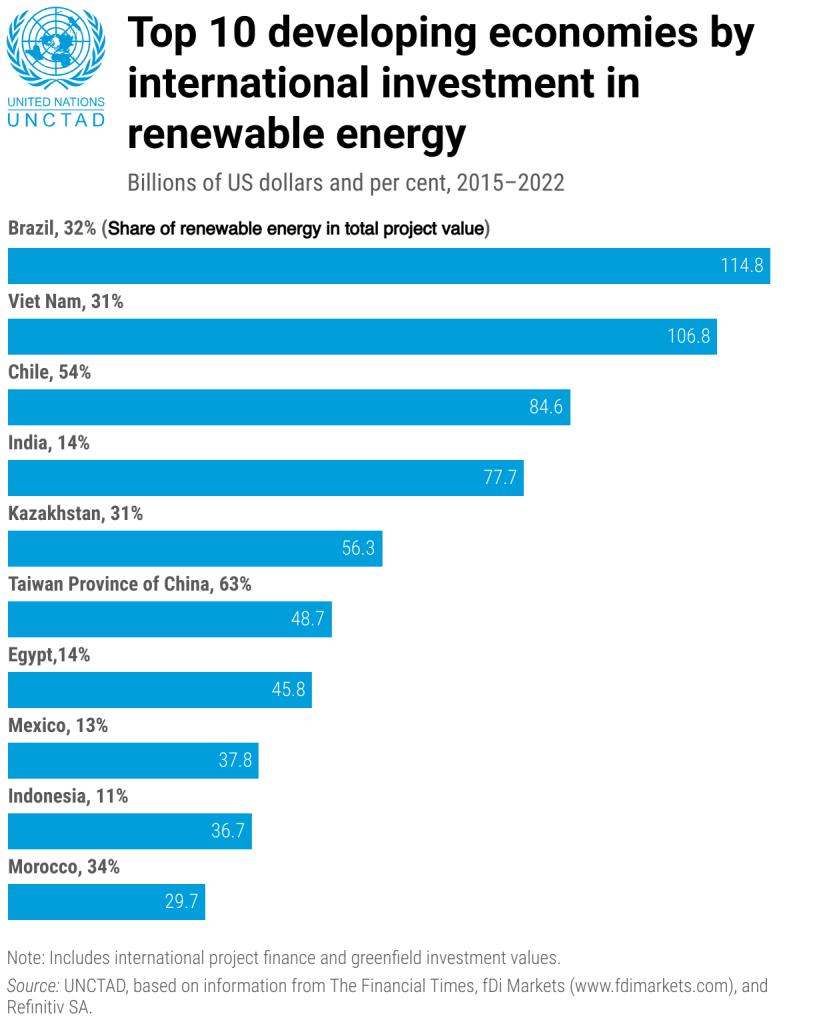Since the ratification of the Paris Agreement in 2015, investments in renewable energy have nearly tripled. However, a significant portion of these investments has been directed towards developed countries. Developing nations require approximately $1.9 trillion annually for investments in renewable energy, including infrastructure like electricity grids, transmission lines, and storage.
According to the 2023 World Investment Report by the United Nations Conference on Trade and Development (UNCTAD), over 30 developing countries have yet to make significant international strides in renewable energy projects. In those developing countries that have attracted the highest levels of international investment in renewable energy, these investments represent anywhere from one-tenth to one-third of total foreign direct investments. High capital costs present a substantial barrier in developing countries where energy investments are seen as riskier endeavors.
The UNCTAD report suggests that partnerships between international investors, the public sector, and multilateral financial institutions can substantially reduce capital costs. For instance, when international investors get involved, debt financing costs decrease by eight percent. Further, the inclusion of Multilateral Development Banks (MDBs) can bring this reduction to ten percent. Combining these efforts in public-private sector partnerships can slash costs by up to forty percent.
Although most developing countries have outlined goals for transitioning to sustainable energy sources, only one-third of them have effectively translated these goals into actionable investment requirements. The UNCTAD report underscores the importance of reducing capital costs for clean energy investments in developing nations and providing additional support in their investment planning and project preparation processes.

Clean Energy Investment Needs to Grow Sevenfold
The report titled “Accelerating Private Sector Finance for Clean Energy in Developing Countries,” released by the International Energy Agency (IEA) and the International Finance Corporation (IFC), also predicts that public financing alone will be insufficient for implementing clean energy investments. To meet the increasing energy demands of developing countries through clean energy sources, annual investments in this sector must rise from $773 billion in 2022 to $2.8 trillion by 2035. According to IEA data, out of the $773 billion invested in clean energy in developing countries in 2022, $511 billion was allocated to China. The remaining $262 billion were invested in other developing countries, with $82 billion in India and other Asian countries, $66 billion in Latin America, $52 billion in the Middle East and Eurasia, $32 billion in Africa, and $30 billion in Southeast Asia.
However, investments in developing countries outside of China need to increase significantly. These countries require clean energy investments to increase from $262 billion to approximately $1.9 trillion, nearly sevenfold. Additionally, private sector financing for clean energy investments in these countries must surpass the current level of $135 billion. In these countries, 775 million people lack access to electricity, and 2.4 billion people lack access to clean cooking facilities.
To mitigate future price increases and volatility risks and achieve a net-zero emissions goal by 2050, a substantial increase in energy investments is essential. It is emphasized that clean energy investments need to exceed $2 trillion by 2030, and in a net-zero emissions scenario, this figure exceeds $4 trillion. Current data highlights the need to attract new investors to the energy sector.
What Is Clean Energy?
Clean energy, also known as renewable energy, refers to energy derived from renewable, zero-emission sources such as bioenergy, solar energy, geothermal energy, hydroelectricity, ocean energy, and wind energy. Today, countries are adopting clean energy technologies and infrastructure to accelerate the transition to a sustainable energy system. Countries investing in renewable energy sources prioritize energy efficiency practices. Clean energy, which does not pollute the air, emit greenhouse gases, or harm the environment, is considered one of the most effective ways to combat climate change.
Kaynaklar
UNCTAD (2023) World envestment report https://unctad.org/publication/world-investment-report-2023
World Energy Outlook (2022) https://iea.blob.core.windows.net/assets/9c36918e-3cf6-4bc1-86e3-038ac3314b18/WEO2022_ES_Turkish.pdf
https://www.aa.com.tr/tr/dunya/cin-haricindeki-gelismekte-olan-ulkelerde-temiz-enerji-yatirimlarinin-7-katina-cikmasi-gerekiyor/2927300#:~:text=Geli%C5%9Fmekte%20olan%20%C3%BClkelerin%20artan%20ihtiyac%C4%B1n%C4%B1n,art%C4%B1%C5%9F%20ihtiyac%C4%B1%20%C3%A7ok%20daha%20y%C3%BCksek.
https://www.bestforenergy.org/temiz-enerji-i-1845#:~:text=Temiz%20enerji%2C%20yenilenebilir%20ve%20s%C4%B1f%C4%B1r,dostu%20enerji%20se%C3%A7enekleri%20dizisini%20ifade
https://www.ipcc.ch/
https://www.energy.gov/


